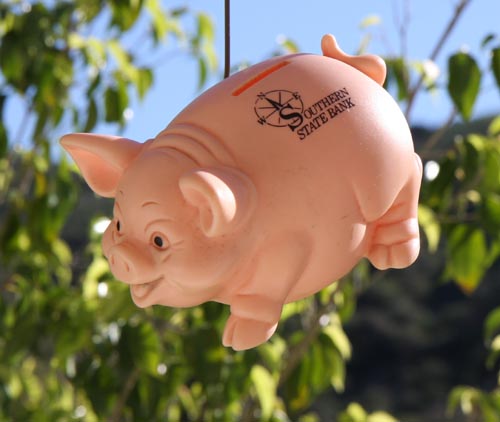 My next painting
is going to document the economic crisis here in
the United States. I will be using vintage banks
to represent the various areas of the economy.
The piggy bank (like the one above) will
represent our personal monetary problems.
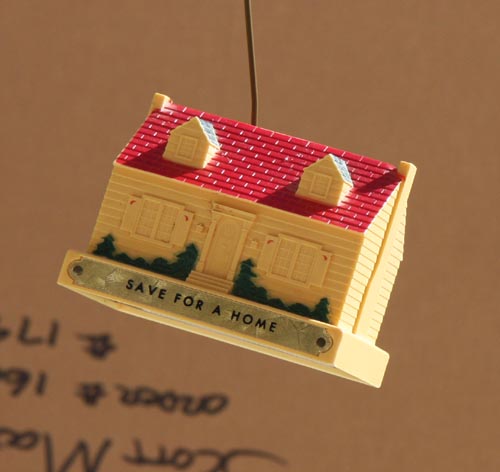
The
plastic home will represent the mortgages.
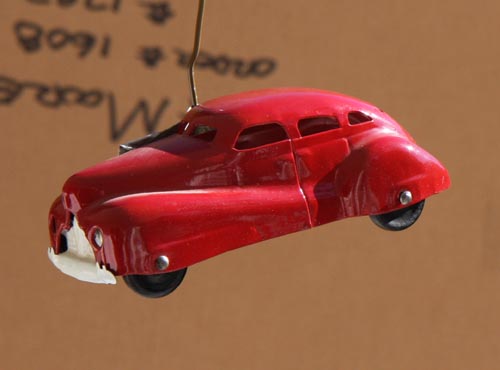
The car
represents the auto industry.

And the
globe bank represents our interests abroad.
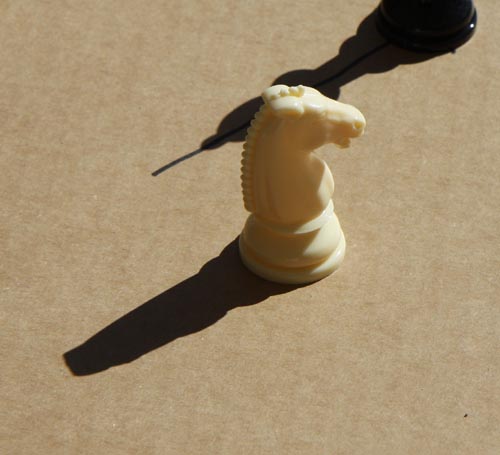
There
will be chess pieces randomly placed across a
spance of chessboard hills, illustrating the
financial 'game' that seems impossible to play.
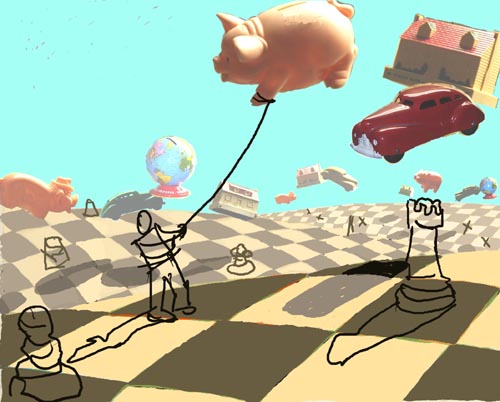
The one
ray of hope will be one lone figure, representing
each of us as we try to hold onto what seems to
be slipping away. The photoshop sketch above is a
crude image of what I have in mind.
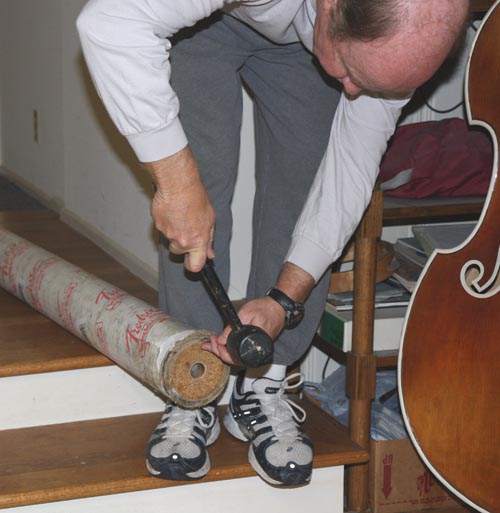
Since
this is a 'big problem', I will be painting this
image on a large scale. Here I am knocking the
plug out of the end of the cardboard tube that
protects the canvas.
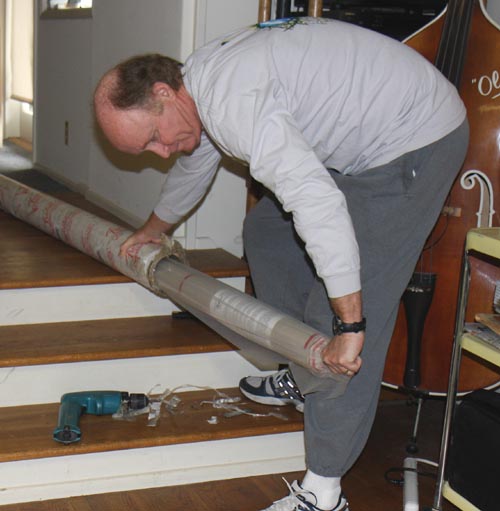
I special
ordered a very large roll of double primed linen
canvas.
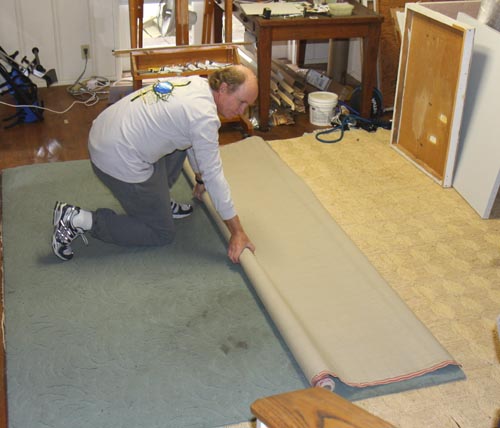
Making
sure that I have a very flat surface to work on,
I next rolled out the linen with the primed
surface facing the floor.
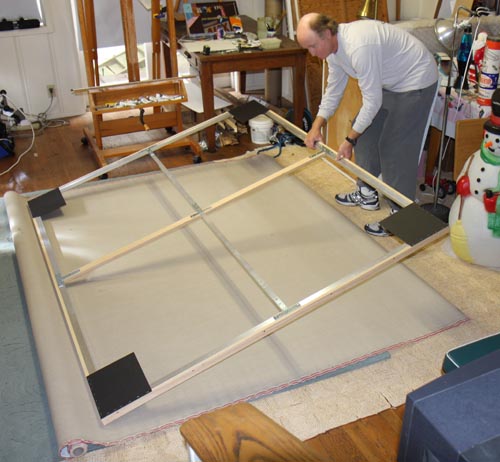
I custom
built stretcher bars, and after squaring up the
corners, I stapled heavy chipboard onto each
corner so that the framework wouldn't tweek when
I moved it around.
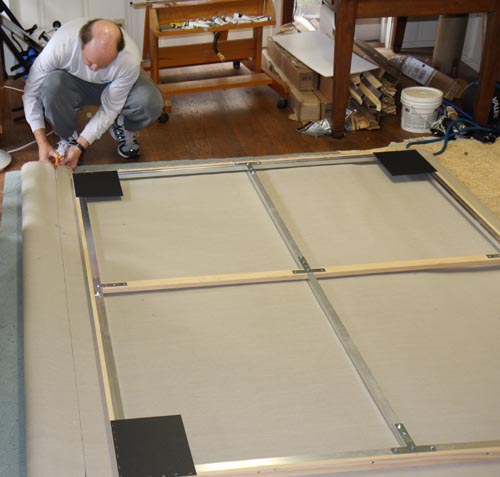
I then
trimmed the linen, leaving about 3 1/2"
around the stretcher bars.
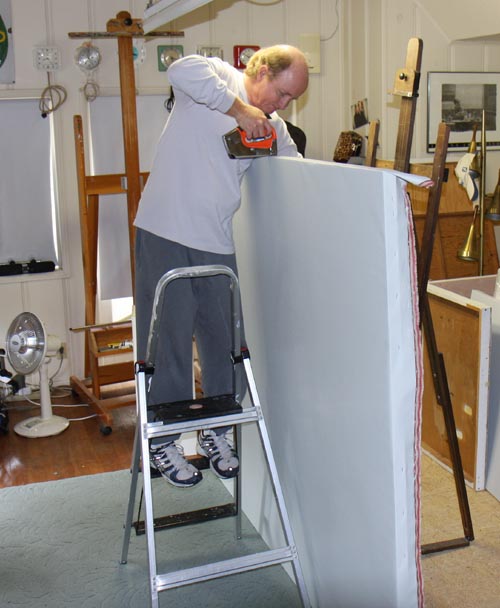
Double
primed linen is very ridgid and takes a lot of
work to get it streched on the frame. This
procedure took over 5 hours.
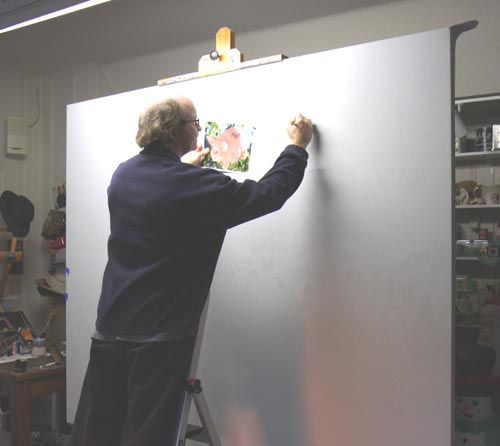
With the
canvas all prepared, I'll spend the next few
weeks drawing the objects of the painting onto
the surface with pencil.
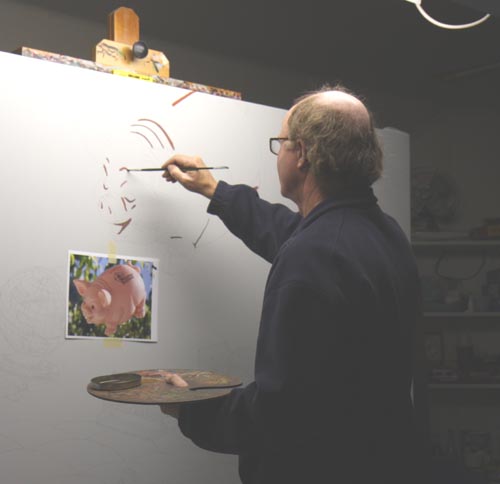
I'm
beginning with the large piggy bank in the
foreground, drawing in some of the darker
accents.
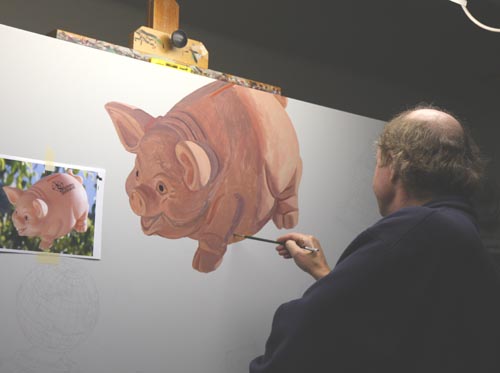
I'm
completing the first pass on this object and will
move onto the house bank to the right.
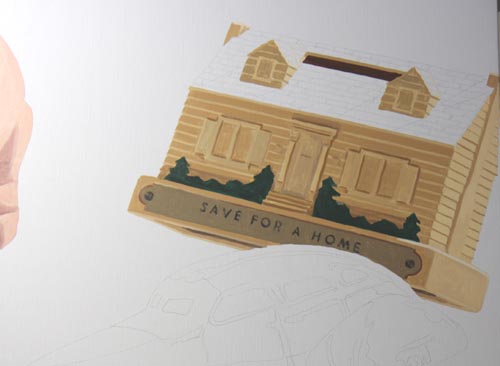
I stopped
short of finishing the first layer of paint on
the house bank, as I realized that the large
expanse of white canvas is making it hard to see
if my values (darks and lights) are correct on
the objects that I am beginning to paint.
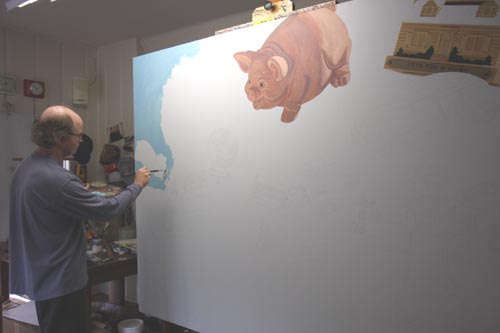
To help
me understand how dark to paint each object, I've
decided to block in the sky. I can then relate
the values to the value of the sky rather than
the white of the canvas.
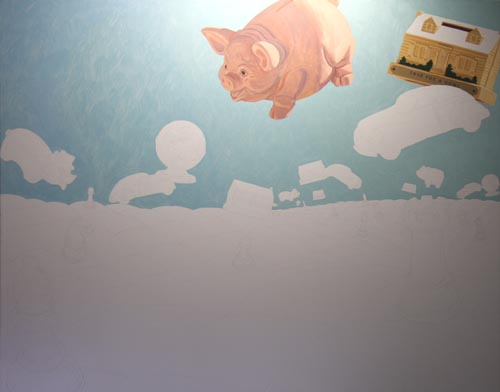
Here's a
look at the canvas with the sky in place.
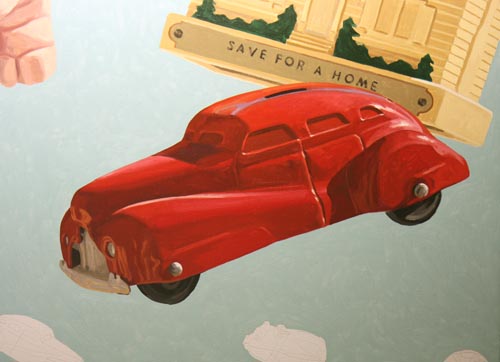
I painted
the car next hoping that its red hue would help
me decide if I also wanted to paint the roof of
the house the same red.
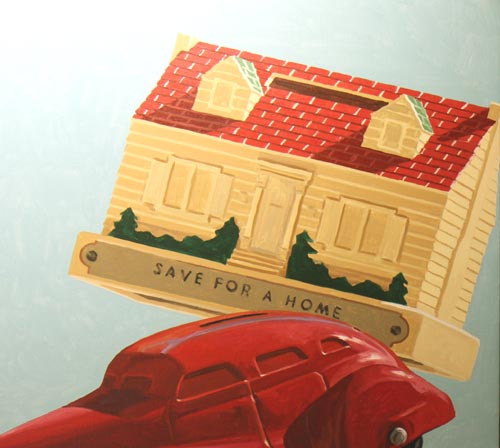
After
some thought I decided to paint the roof just
like the real object.
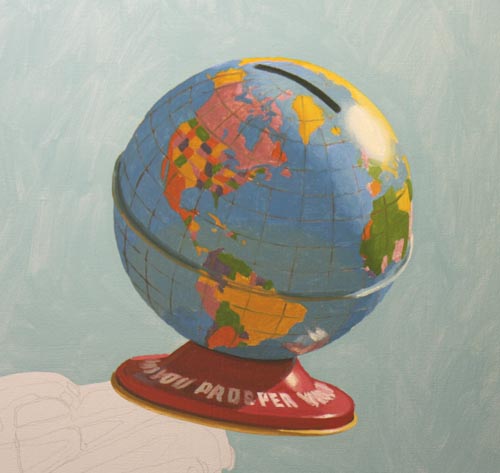
I kept
the detail in the tin globe bank since it is in
the middleground area.
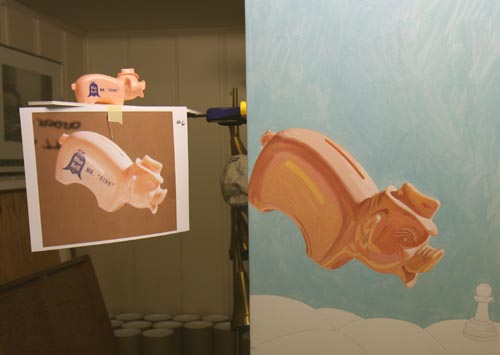
I keep
the actual objects close by to help with the
rendering. I'll 'soften' the surface of this
piggy bank when I apply the final paint.
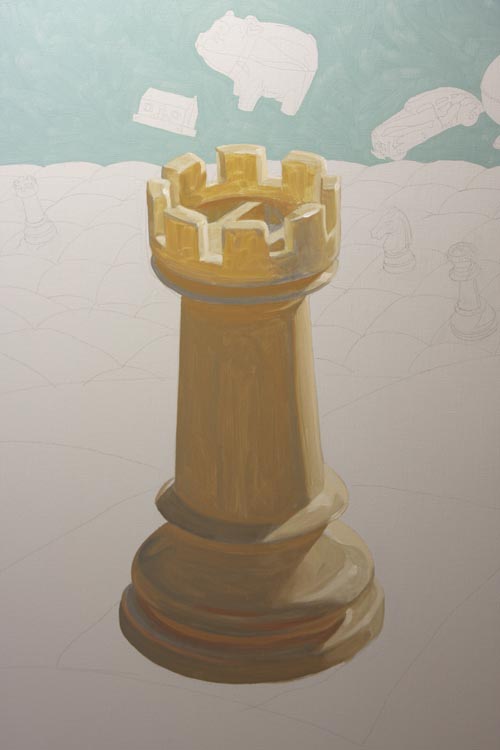
I've left
the sky to get an idea of the value range that I
will be using on the foreground objects. I
painted the rook and...
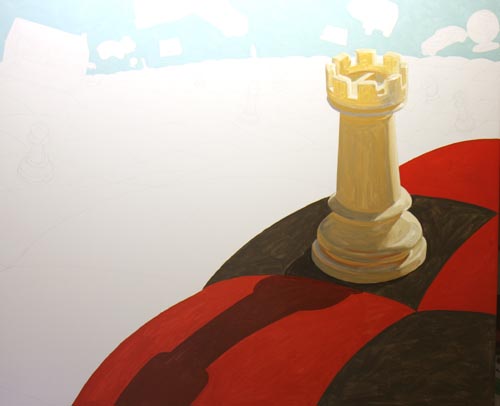
...a few
of the squares on the fabric chessboard.
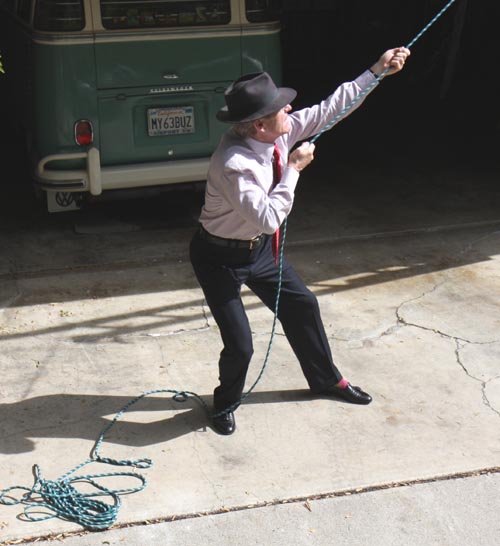
Today the
sun was out and Budge, a good friend and client
posed as my businessman for this painting. I tied
a rope onto the end of an extension ladder which
I lashed to the house (you can see the shadow of
the ladder on the cement just past Budge). This
is the last component of the painting, so I'll
draw him onto the canvas next.
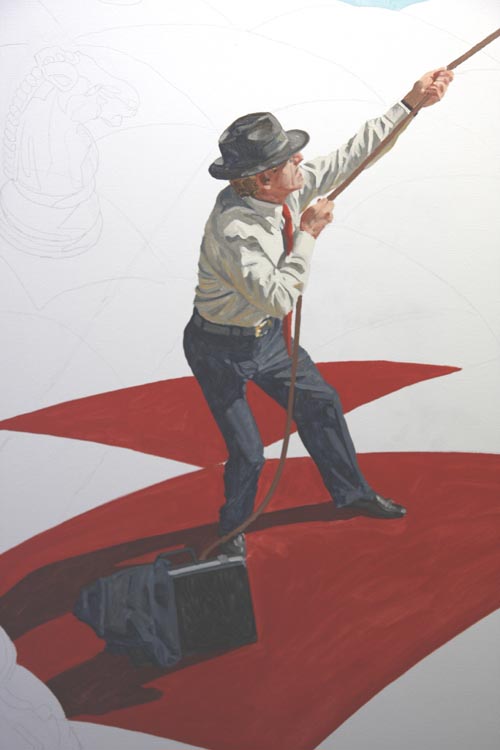
The human
element is positioned and roughed in.
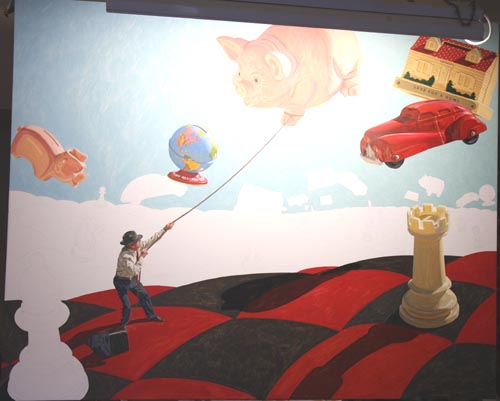
I've
painted the rest of the black and red squares in
the foreground.
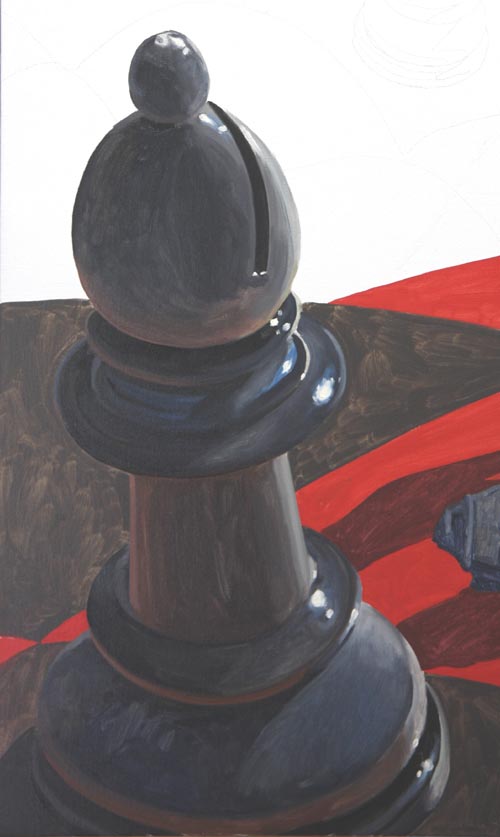
Here's a
closeup of the bishop in the left front of the
painting.
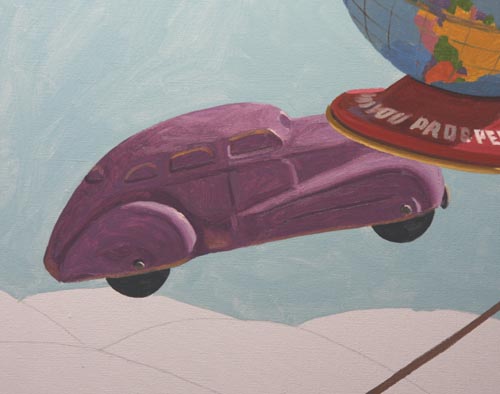
The car
in the middle ground is sketched in with thin oil
paint.
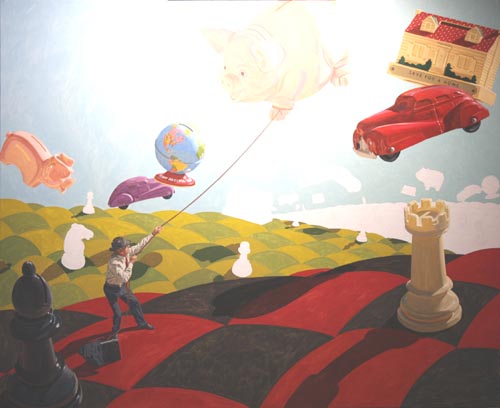
The
middle ground, has been painted in with the
yellow and green quilted squares, along with the
cast shadows.
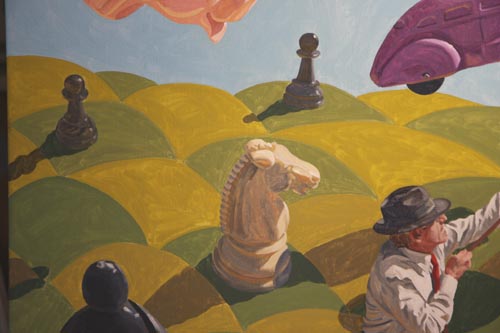
I've
painted in a couple of chessmen and added a black
pawn on the left.
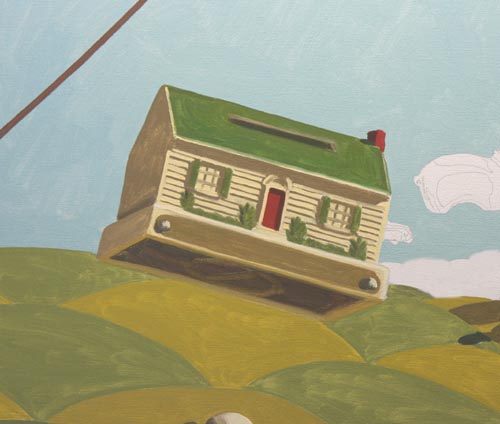
Another
'house bank' is sketched in oil.
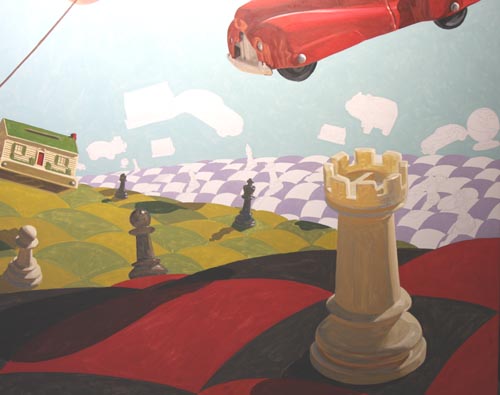
I've
begun to paint in the distant hill, using a cool
purple hue.
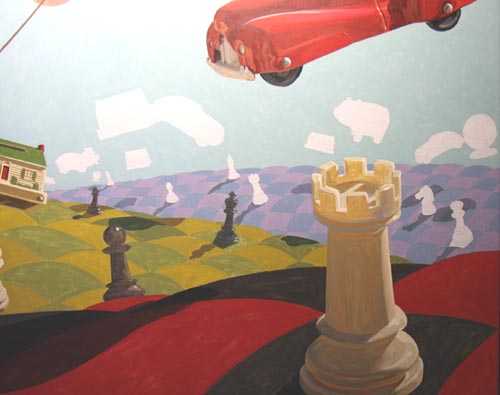
The
distant hill now has its two cool shades of color
and I'm also positioning the cast shadows from
both the chess pieces and the floating objects.
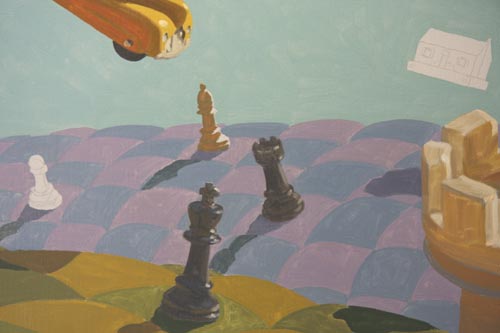
With the
distant hill established, I'll now paint in the
chess pieces that sit on it.
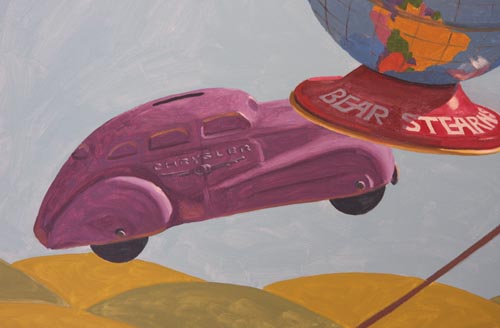
I'm also
beginning to label some of the objects in the sky
with the names and logos/logotypes of failing
institutions.
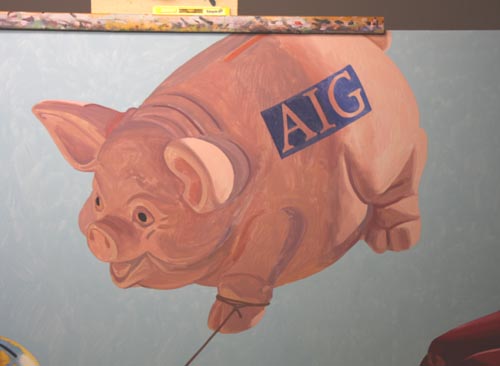
AIG is on
the forefront of the failing companies and also
gets a high profile position in my painting.
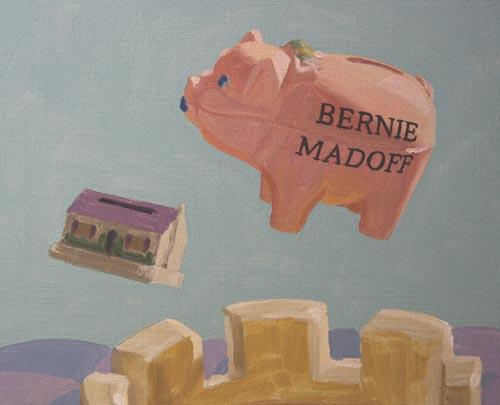
And the
beat goes on...
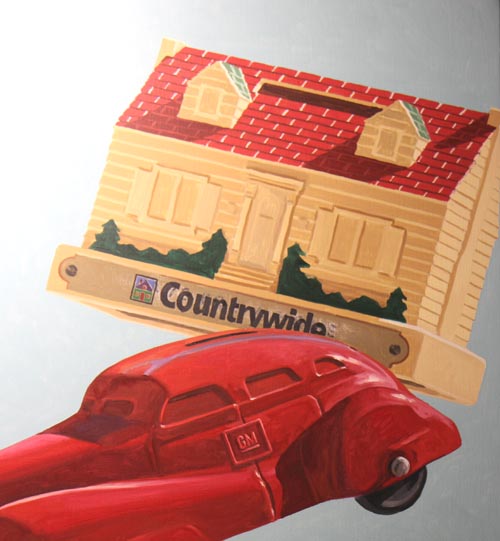
Countrywide
& GM...
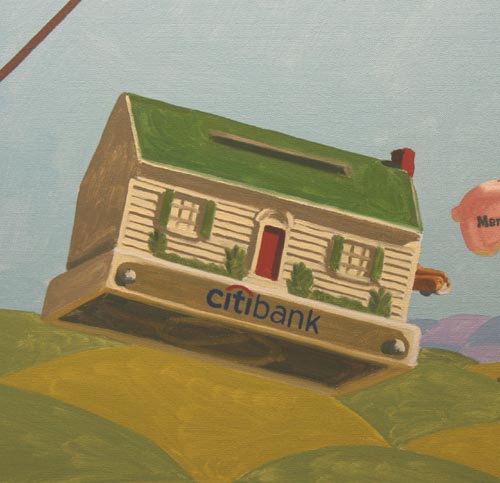
Citibank...
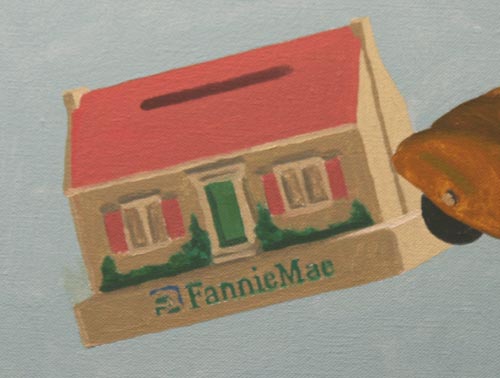
Fannie
Mae...
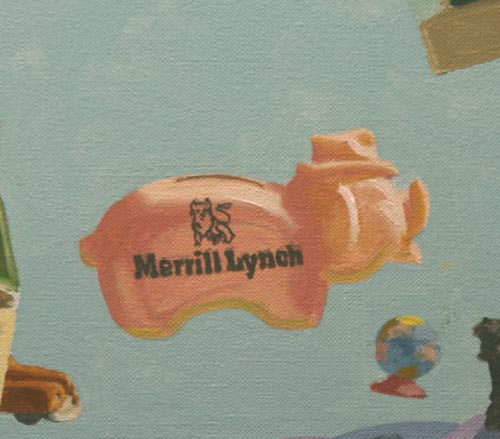
Merrill
Lynch...
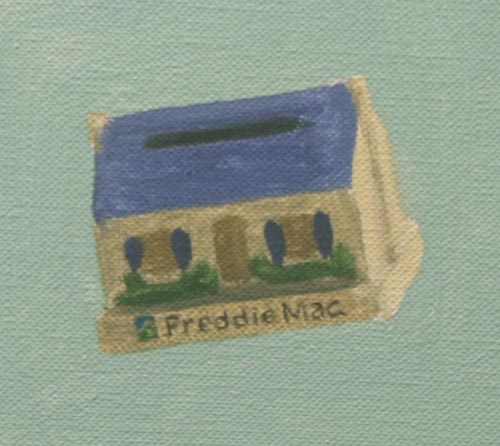
Freddie
Mac...
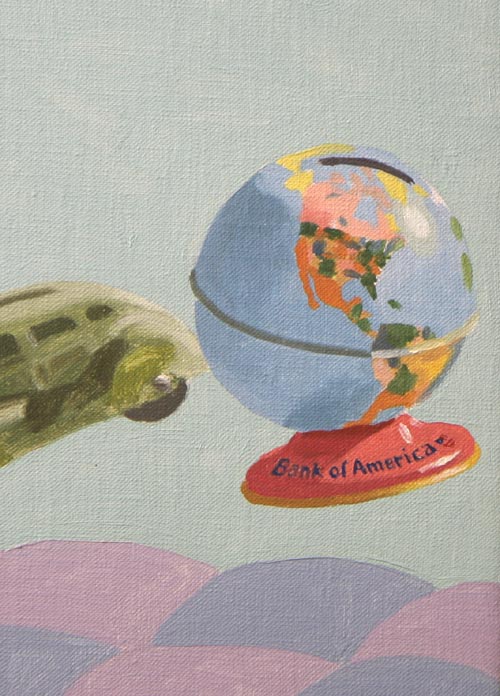
...and
Bank of America.
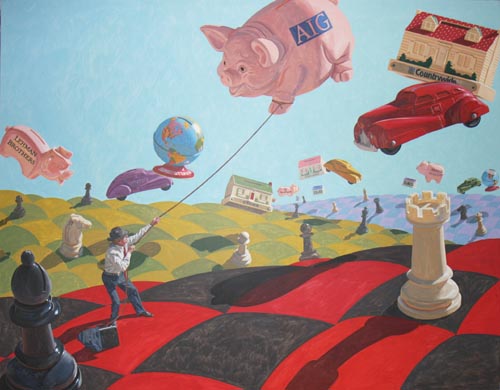
Here is
the entire painting with all the objects given
their first layer of paint. Now the task of
adjusting the values to create some atmosphere
between the foreground and the background. This
will be done by painting the foreground
(red/black squares, AIG pig, GM car, Countrywide
house, the bishop, the rook and the businessman)
first, making them as strong as possible with the
darkest values and the most colorful hues. All
the other objects will be lightened to make the
foreground dominant, but not to the point where
it is impossible to see the detail in the distant
objects.
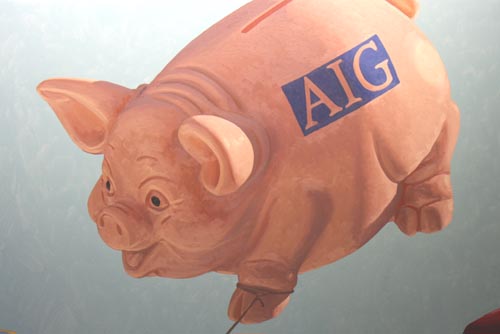
Here is
the first object with its final coat of paint.
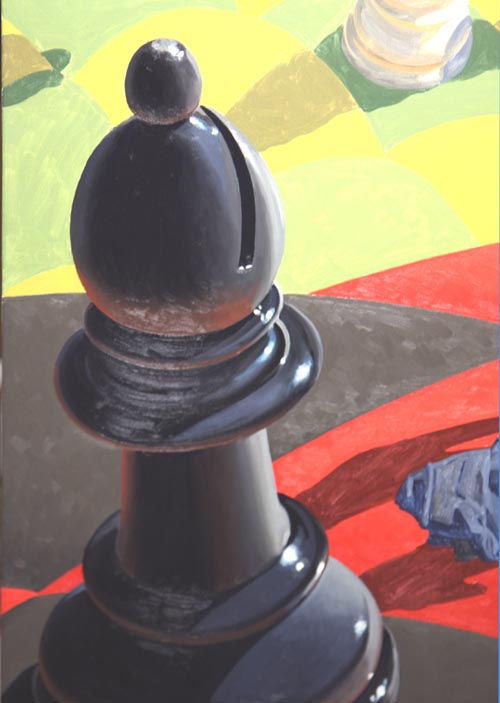
The
bishop is finished. Notice the reddish glow
reflected from the red in the chess squares.
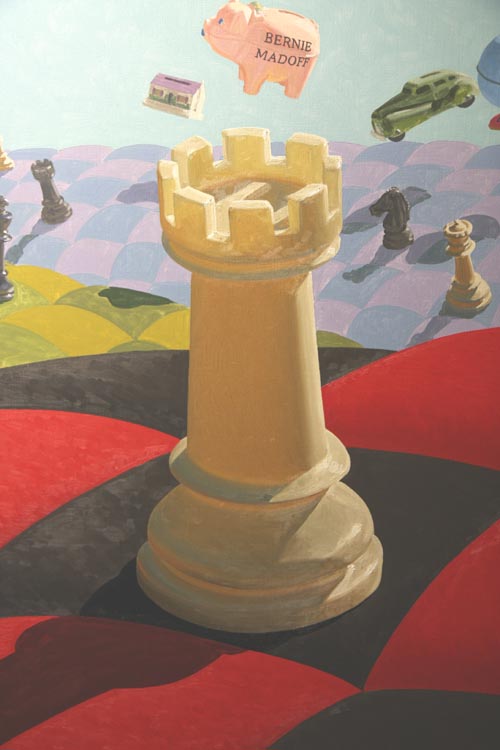
The rook
has taken on a nice transparent glow from the sun
passing through its plastic body.
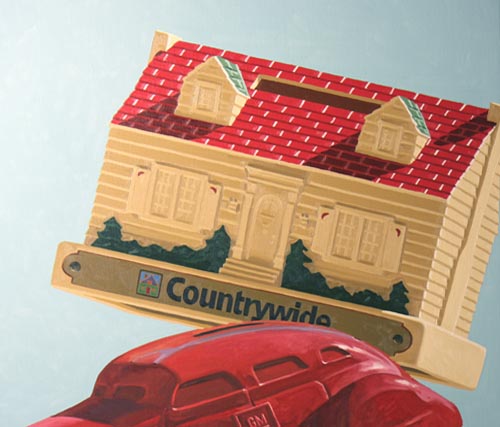
The
'Countrywide House' is finished.
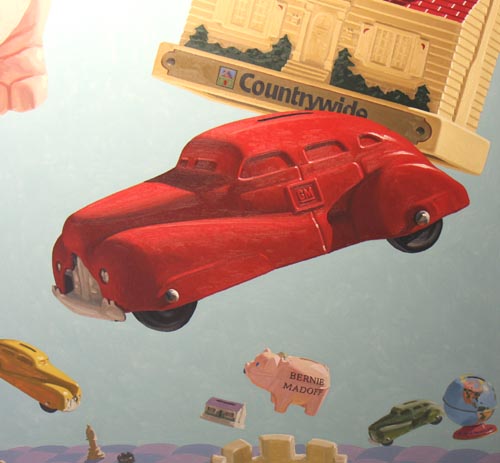
The 'GM
car' is done. I changed the hue of the car from a
cool red to a warm red so that it separated
itself from the red on the roof of the
'Countrywide Bank' and the cooler red squares in
the foreground 'chess quilt'.
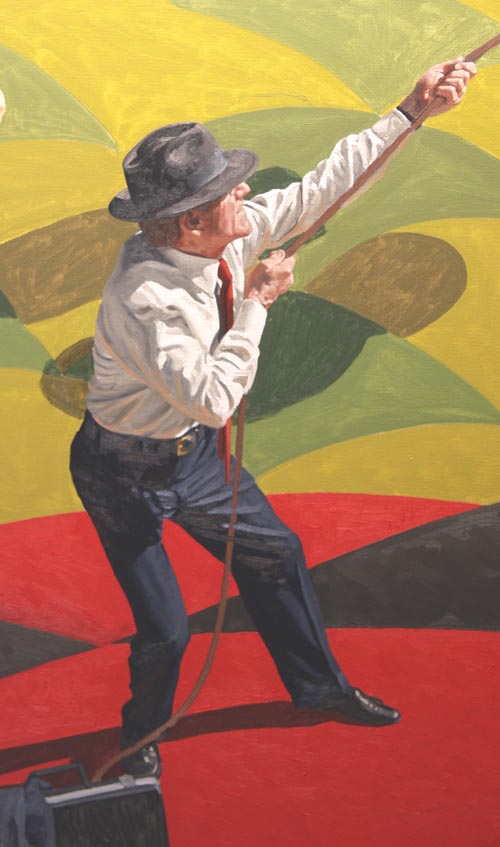
I've just
completed the figure and when I paint one more
small chess piece that sits on the red and black
squares, I'll be able to evaluate the hue and
value difference between the foreground and the
middleground.
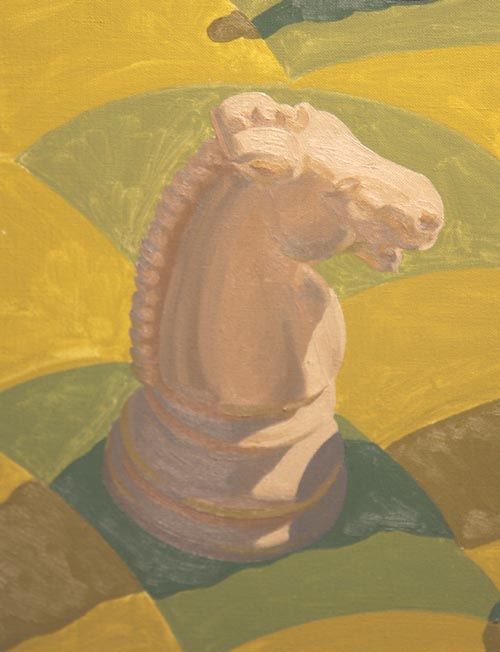
I've
tried to establish the value (darkness) of the
middle ground chess pieces by painting the knight
first. I've lightend the shadow areas and
darkened the highlight areas so that they are
closer together in value. This softens the
contrast and visually makes the object appear to
be off in the distance.
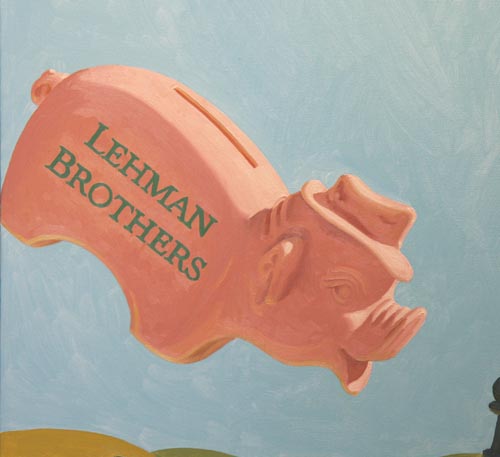
I also
painted my first object that is floating in the
middleground 'zone', adjusting the light and dark
values so that they too have less contrast.
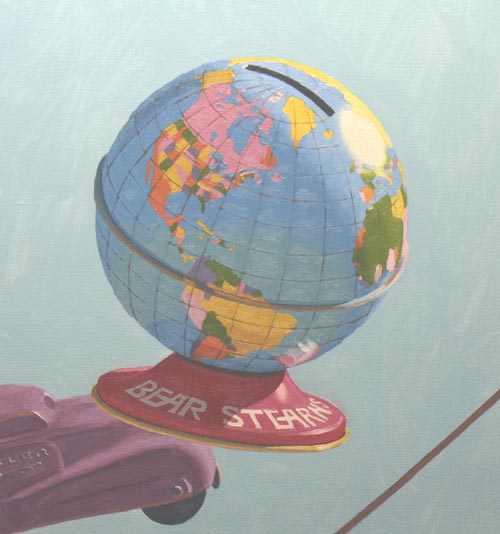
I
softened the values in the 'Bear Stearns' bank.
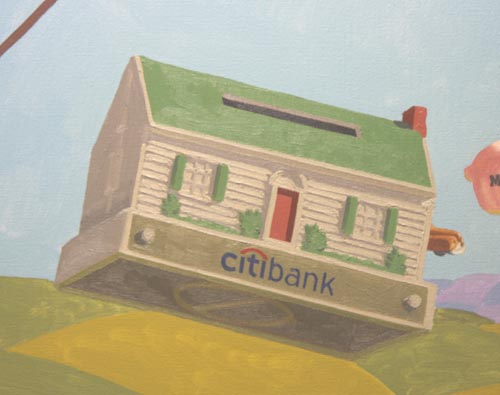
As well
as the 'Citibank' bank.
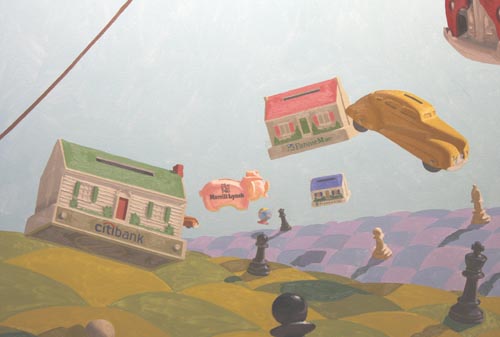
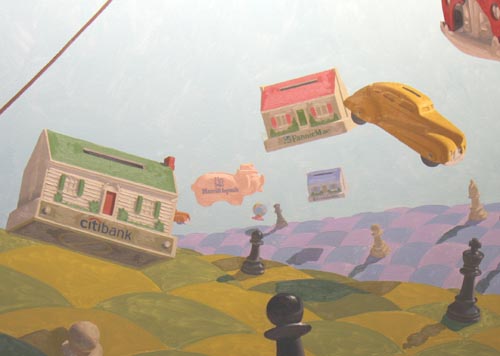
If you
look at the two photos above, you will see the
change that has taken place between the
middleground and the background. The objects
(Merrill Lynch pig, Freddie Mac house, the three
chess pieces etc.) in the background have been
lightened and the contrast in their values has
been decreased, making them recede into the
distance.
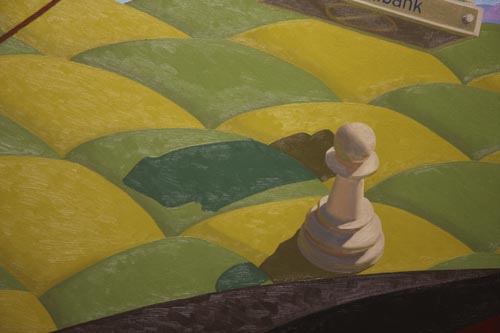
I've
painted in the middle ground chessboard squares
and I've shaded them to give a pillowy quilted
look.
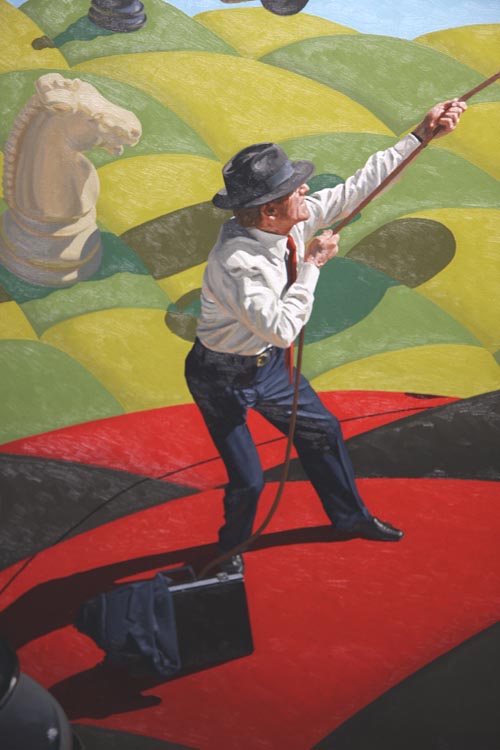
Here's a
detail of the man again, showing the finished
middleground area behind him. Note that the
brightness of his shirt (its highlight values) is
lighter than the brightest highlights on the
knight chess piece. This creates visual distance
between the two planes.
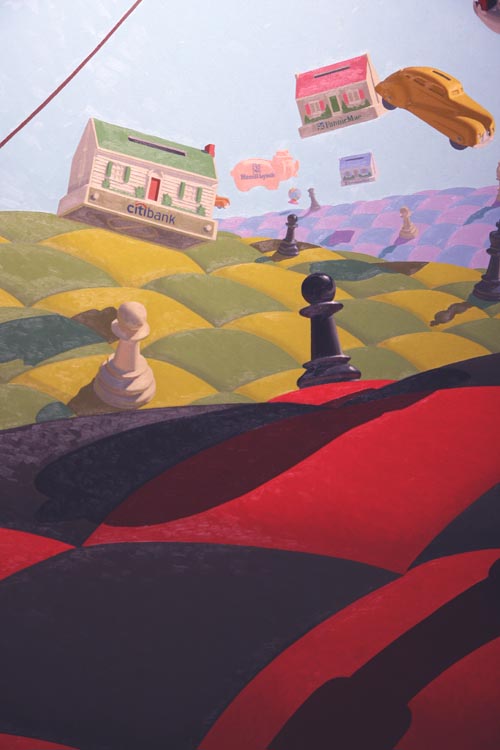
Here's a
good view that shows the three distances I've put
in the painting (foreground, middleground and
background). The intensity and darkest values are
in the foreground, with the colors muting and
then going cool as they get to the distant
background.
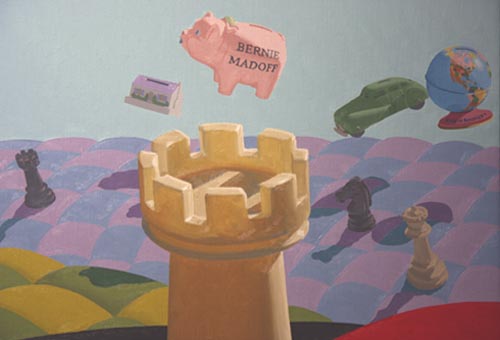
Another
detail, showing the top of the rook in the
foreground and how the softening (lighter values
and less intense hues) of the background objects
helps create the atmospheric separation needed to
separate the planes.
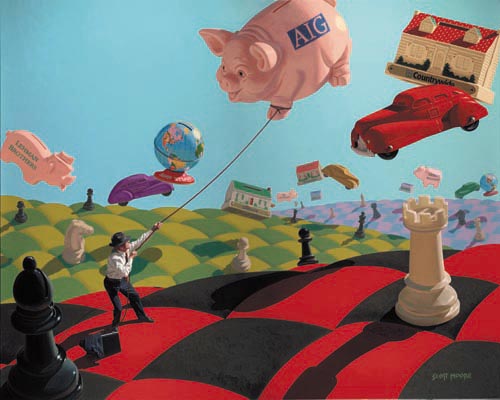
Here's
the finished painting! I just had it scanned to
get this very crisp image! I love it!
|